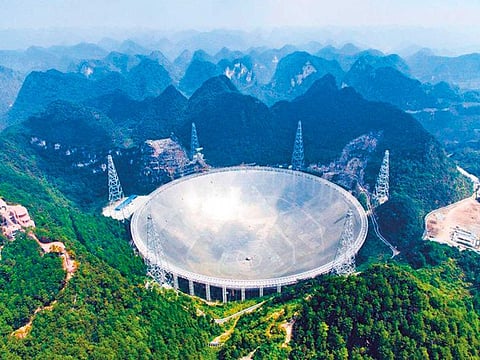Why Chinese scientists are buying return tickets
Investments in education and research facilities are luring them back to China’s labs

China’s most sprawling effort at revealing the universe’s deepest mysteries is a 1,640-foot-wide silver dish that settles comfortably between hills in a remote part of the country’s southwest. The Five-hundred-metre Aperture Spherical Telescope (Fast) is more sensitive than any telescope on Earth. This month, the Chinese government announced that it had begun formal operations. Fast is expected to further human understanding of gravitational waves and cosmic rays, and — just possibly — detect extraterrestrial communications. But for the Chinese government, which spent $180 million (Dh661 million) on the massive instrument, the most important return on its investment will be the homecoming of Chinese scientists who have been living and researching abroad.
According to a recent study in the journal Science and Public Policy, it’s been happening for a while. The number of Chinese scientists who departed the United States for China in 2017 was 69 per cent higher than 2010 departures. The factors driving this phenomenon are complex but come down to the Chinese government’s decades-long investments in scientific education, research and facilities like Fast. Those efforts are likely to accelerate the return of China’s scientists in coming years, and they will bring economic, geopolitical and cultural benefits with them. In time, they could challenge the pre-eminence of American science.
A rising tide of returnees was not preordained. As recently as the late 1970s, China’s universities and its science were a shambles. The Cultural Revolution had created a “missing generation” of scientists. To narrow the gap, Deng Xiaoping, China’s reformist leader, resolved to send thousands of students abroad. Eventually, he hoped, a few might come back and make improvements. As of 2017, China had allowed, and often paid for, 5.2 million students to get better educations abroad.
Global R&D spending
China also invested extensively in universities and university enrolment, creating the world’s largest (and improving) population of engineers and scientists, while funding research and development at world-beating rates. From 2000 to 2017, Chinese spending on research and development grew more than 17 per cent per year, compared with 4.3 per cent per year in the United States. The Americans kept a slim lead in total spending — the United States accounted for 25 per cent of global R&D spending in 2017, compared with 23 per cent for China — but that gap is narrowing (and may have flipped in China’s favour in 2019).
Spending is an imperfect measure of scientific leadership, but there’s no question that China has earned dividends from its efforts. Today it’s in the global vanguard for key fields, including artificial intelligence, nanotechnology and biotechnology.
Those advances won’t bring back all of the young talent that’s left China over the decades — the US is still the world’s scientific superpower — but they certainly help. The Fast facility is a good example of how this might work. Chinese scientists have been involved in radio astronomy for decades. But because the biggest and best radio telescopes were all abroad — notably, the Arecibo Observatory in Puerto Rico — Chinese radio scientists were reliant upon host scientists and countries for research opportunities and collaborators. The commissioning of Fast flips the tables. Li Di, Fast’s chief scientist, earned his doctorate at Cornell University, and previously worked as a research scientist at the Jet Propulsion Laboratory in Pasadena, California. Now he’s in China. International collaborators will be welcome at Fast, but China will set the agenda, allot the telescope time, and — ultimately — reap the bulk of the benefits.
Career paths
In the Science and Public Policy study released in December, researchers traced the career paths of Chinese scientists via the addresses associated with their scientific publications (a necessary approach, because of the lack of reliable data on either side of the Pacific). In 2017, 4,569 Chinese scientists left the United States for China, compared with 2,703 in 2010. Even more notable than the scale of the return is the quality. Twelve per cent of China’s scientific publications were written by scientists with overseas experience, and the share of high impact publications — those that are regularly cited by other scientists — is higher than peers who remained in China. Those scientists, in turn, train younger Chinese scientists and connect them to the increasingly global nature of scientific inquiry in the 21st century.
For now, there is still more talent flowing into the United States than out of it. But the quickening uptick of China’s scientific returnees should serve as a powerful reminder that scientific superpower status requires constant investment and a commitment to openness and collaboration across borders. For decades, the United States has attracted and benefited from Chinese scientific talent because it made those commitments. China’s research investments mean that the United States needs to reaffirm them, or risk ceding its accustomed role as the world’s undisputed scientific leader.
— Bloomberg
Adam Minter is a Bloomberg Opinion columnist.
Sign up for the Daily Briefing
Get the latest news and updates straight to your inbox


